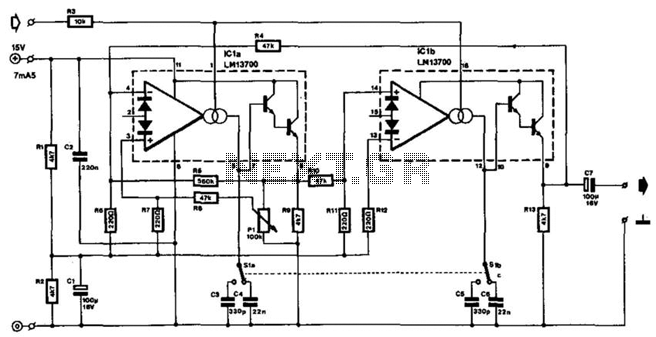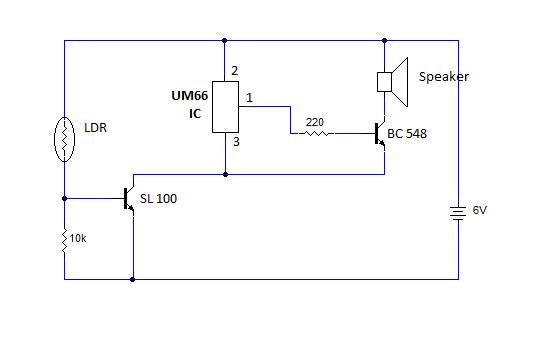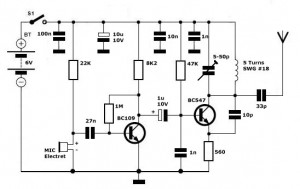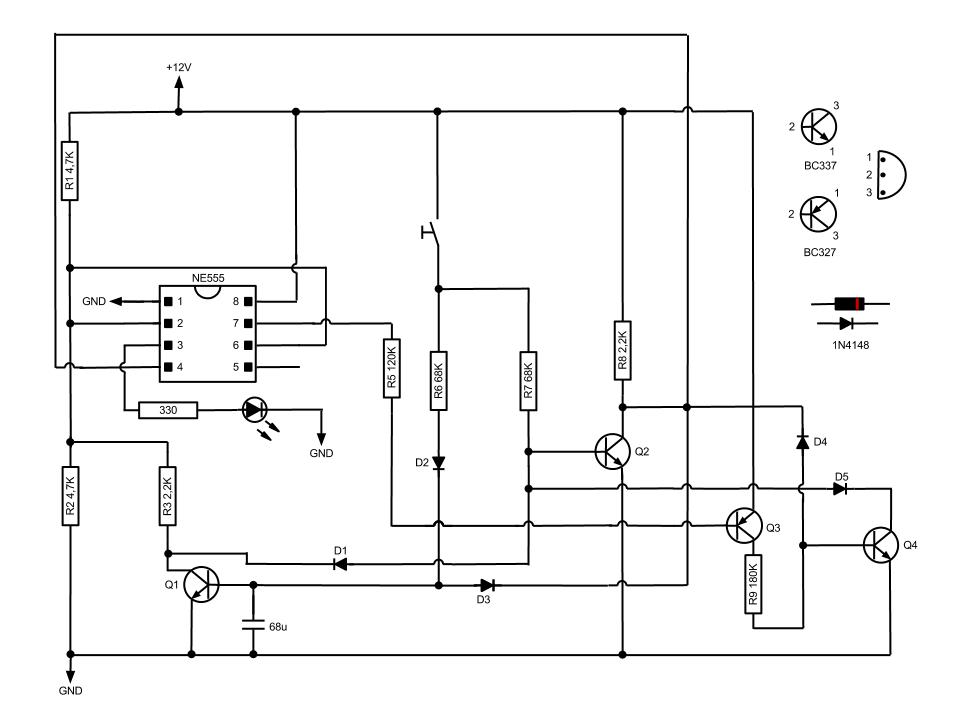
Simple Audio-Frequency Vco

The frequency of this sine-wave oscillator is determined by a direct voltage, U, ranging from 0 to 15 V. The distortion in output signals of up to 10 Vpp does not exceed 1%. When the output is reduced using P1 to 1 Vpp, the distortion drops to below 0.1%. It is not recommended to use output signals below 1 Vpp, as the oscillator may become unstable and temperature-dependent. The oscillator comprises two operational transconductance amplifiers (OTAs) housed in a single package. The Amp-bias inputs, pins 1 and 16, are connected in parallel and can drive the output currents at pins 5 and 12 to a peak value of up to 0.75 mA. Switch S1 allows the oscillator output to be set to two frequency ranges: 6.7 to 400 Hz and 400 Hz to 23.8 kHz. The overall frequency range requires a control voltage that varies from 1.34 to 15 V. When the frequency is adjusted by changing Uc without altering the setting of P1, the output signal may become distorted. Therefore, the amplitude of the signal must be adjusted according to the frequency.
The sine-wave oscillator operates by utilizing two operational transconductance amplifiers (OTAs), which are configured to generate a stable sine wave output. The frequency of oscillation is directly influenced by the control voltage (U), which can be varied between 0 and 15 V. This adjustable frequency capability allows for versatility in various applications, from low-frequency signals at 6.7 Hz to high-frequency outputs reaching 23.8 kHz.
The output characteristics are designed to maintain low distortion levels, with a maximum distortion of 1% for output signals up to 10 Vpp. Notably, when the output is set to a lower amplitude of 1 Vpp by adjusting potentiometer P1, distortion levels improve significantly to below 0.1%. However, operating the oscillator at output levels below 1 Vpp is inadvisable, as this can lead to instability in the circuit and make it more sensitive to temperature variations.
The configuration of the OTAs includes parallel connections of the Amp-bias inputs (pins 1 and 16), which allows for increased output drive capability, reaching up to 0.75 mA at the output pins (5 and 12). This design choice enhances the oscillator's ability to drive loads while maintaining the desired signal integrity.
To facilitate user control over the frequency output, switch S1 provides a means to select between two distinct frequency ranges. This feature is essential for applications requiring specific frequency outputs, enabling quick adjustments without the need for complex circuitry changes.
It is crucial to note that when adjusting the frequency via the control voltage (Uc), the amplitude setting via P1 must also be appropriately managed to avoid signal distortion. This relationship between frequency and amplitude is fundamental to the oscillator's performance, ensuring consistent and reliable operation across its specified frequency range. The frequency of this sine-wave oscillator is determined by a direct voltage, U" of 0 to 15 V. The distortion on output signals of up to 10 Vpp is not greater than 1 o/o. When the output is reduced with the aid of P1 to 1 Vpp, the distortion drops to below 0.1 o/o. It is not recommended to use output signals below 1 Vpp, because the oscillator then becomes unstable and temperature-dependent. The oscillator consists of two operational transconductance amplifiers (OTAs) contained in one package.
Their Amp-bias inputs, pins 1 and 16, are connected in parallel. These inputs can drive the output currents at pins 5 and 12 to a peak value of up to 0. 75 rnA. Switch S1 enables the oscillator output to be set to two ranges: 6. 7 to 400Hz and 400Hz to 23.8 kHz. The overall range needs a control voltage that varies from 1.34 to 15 V. When the frequency is changed by a variation of Uc and the setting of P1 is not altered, the output signal might be distorted. In other words, the amplitude of the signal must be adapted to the frequency.
The sine-wave oscillator operates by utilizing two operational transconductance amplifiers (OTAs), which are configured to generate a stable sine wave output. The frequency of oscillation is directly influenced by the control voltage (U), which can be varied between 0 and 15 V. This adjustable frequency capability allows for versatility in various applications, from low-frequency signals at 6.7 Hz to high-frequency outputs reaching 23.8 kHz.
The output characteristics are designed to maintain low distortion levels, with a maximum distortion of 1% for output signals up to 10 Vpp. Notably, when the output is set to a lower amplitude of 1 Vpp by adjusting potentiometer P1, distortion levels improve significantly to below 0.1%. However, operating the oscillator at output levels below 1 Vpp is inadvisable, as this can lead to instability in the circuit and make it more sensitive to temperature variations.
The configuration of the OTAs includes parallel connections of the Amp-bias inputs (pins 1 and 16), which allows for increased output drive capability, reaching up to 0.75 mA at the output pins (5 and 12). This design choice enhances the oscillator's ability to drive loads while maintaining the desired signal integrity.
To facilitate user control over the frequency output, switch S1 provides a means to select between two distinct frequency ranges. This feature is essential for applications requiring specific frequency outputs, enabling quick adjustments without the need for complex circuitry changes.
It is crucial to note that when adjusting the frequency via the control voltage (Uc), the amplitude setting via P1 must also be appropriately managed to avoid signal distortion. This relationship between frequency and amplitude is fundamental to the oscillator's performance, ensuring consistent and reliable operation across its specified frequency range. The frequency of this sine-wave oscillator is determined by a direct voltage, U" of 0 to 15 V. The distortion on output signals of up to 10 Vpp is not greater than 1 o/o. When the output is reduced with the aid of P1 to 1 Vpp, the distortion drops to below 0.1 o/o. It is not recommended to use output signals below 1 Vpp, because the oscillator then becomes unstable and temperature-dependent. The oscillator consists of two operational transconductance amplifiers (OTAs) contained in one package.
Their Amp-bias inputs, pins 1 and 16, are connected in parallel. These inputs can drive the output currents at pins 5 and 12 to a peak value of up to 0. 75 rnA. Switch S1 enables the oscillator output to be set to two ranges: 6. 7 to 400Hz and 400Hz to 23.8 kHz. The overall range needs a control voltage that varies from 1.34 to 15 V. When the frequency is changed by a variation of Uc and the setting of P1 is not altered, the output signal might be distorted. In other words, the amplitude of the signal must be adapted to the frequency.





